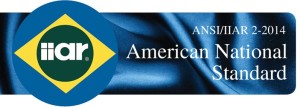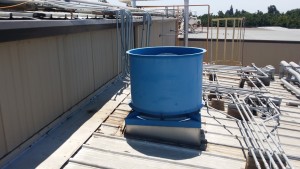Machinery Room Ventilation Requirements

In this week’s blog post we will summarize the machinery room ventilation requirements contained within ANSI/IIAR 2-2014. We have broken down the ventilation requirements into three (3) categories:
- Design and Installation
- Control
- Testing
Some of the requirements overlap and are listed in more than one of the categories.

Design and Installation
- When occupied, the machinery room must be ventilated with outside air at a rate of of not less than 0.5 cfm/ft2 of machinery room area or 20 cfm/occupant, whichever is greater. [6.14.1]
- Exhaust air ducts from the machinery room and intakes for make-up air must serve only the machinery room. [6.14.3.3, 6.14.5.5]
- Emergency ventilation fans must discharge upward at a minimum velocity of not less than 2,500 fpm at the required emergency ventilation (capacity) flow rate. [6.14.3.5]
- Exhaust fans, regardless of function, must have nonsparking blades. [6.14.3.6]
- Emergency ventilation fan motors located in the air stream or inside the machinery room must be of the totally enclosed type. [6.14.3.7]
- Multiple fans or multispeed fans are permitted to provide both temperature control and emergency ventilation. [6.14.4]
- Ventilation must exhaust to the outdoors and make-up air must be provided from the outdoors. Make-up and exhaust must be positioned to avoid short-circuiting and drawing contaminated air. [6.14.3, 6.14.5.1, 6.14.5.2, 6.14.5.4]
- Make-up air must be covered with a corrosion-resistant screen of not less than ¼ in mesh or equivalent. [6.14.5.3]
- Exhaust termination must be to the outdoors and no fewer than 20 ft from a property line or opening to a building. [6.14.3.4]
- Ventilation must not cause the negative pressure in the room to exceed 0.25 in water column. [6.14.5.1]
- If used, motorized louvers/dampers must fail to the open position during a loss of power. [6.14.5.6]
- Temperature control ventilation must limit the dry bulb temperature to 104°F taking into account the heat load of the machinery and the make-up air entering the room at 1% design. Emergency ventilation can be used to supplement temperature control ventilation. Reduced temperature control ventilation rate can be used if supported by engineering design (external means of cooling or electrical wiring rated for higher temperatures). [6.14.6.1]
- Temperature control ventilation must be continuous or activated by both: 1. Thermostat; 2. Manual control switch. Partial operation of multiple-fan or multispeed fan systems is permitted to deliver the temperature control ventilation. [6.14.6.2]
- Emergency ventilation must provide 30 air changes per hour based on the gross machinery room volume unless analysis indicates that a release of the entire system charge will not result in the room concentration exceeding 40,000 PPM (25% LFL) [6.14.7.1]
- A clearly identified control switch for emergency ventilation with a tamper-resistant cover must be located outside the machinery room and adjacent to the designated principal machinery room door. The switch must provide ON/AUTO override capability and be clearly labeled. [6.12.2]
- Emergency ventilation must be powered independently of the machinery room equipment and not affected by the emergency shutdown controls. [6.14.7.3]
Control
- When occupied, the machinery room must be ventilated with outside air at a rate of not less than 0.5 cfm/ft2 of the machinery room area or 20 cfm/occupant, whichever is greater. [6.14.1]
- Detection of ammonia concentrations equal to or exceeding 25 ppm shall activate visual indicators and audible alarms and shall activate an alarm that reports to a monitored location so that corrective action can be taken at an indicated concentration of 25 ppm or higher.
- Emergency ventilation must be activated by the ammonia detection system at a concentration of 150 PPM and by a manual control switch. [6.12.2, 6.13.2.3, 6.14.3.1, 6.14.7.2]
- If used, motorized louvers/dampers must fail to the open position during a loss of power. [6.14.5.6]
- Temperature control ventilation must limit the dry bulb temperature to 104°F taking into account the heat load of the machinery and the make-up air entering the room at 1% design. Emergency ventilation can be used to supplement temperature control ventilation. Reduced temperature control ventilation rate can be used if supported by engineering design (external means of cooling or electrical wiring rated for higher temperatures). [6.14.6.1]
- Temperature control ventilation must be continuous or activated by both: 1. Thermostat; 2. Manual control switch. Partial operation of multiple-fan or multispeed fan systems is permitted to deliver the temperature control ventilation. [6.14.6.2]
- A clearly identified control switch for emergency ventilation with a tamper-resistant cover must be located outside the machinery room and adjacent to the designated principal machinery room door. The switch must provide ON/AUTO override capability and be clearly labeled. [6.12.2]
- Emergency ventilation must be powered independently of the machinery room equipment and not affected by the emergency shutdown controls. [6.14.7.3]
- Loss of power or failure of the emergency ventilation must result in a signal being sent to a monitored location. [6.14.7.4]
- General exhaust fans which are not used to provide temperature control or emergency ventilation, must be shut off with refrigeration machinery in the event of a concentration that exceeds 150 PPM [6.14.2]
Testing
- A schedule for testing the ventilation system must be established based on manufacturer’s recommendation and documented experience. Where recommendations are not provided, the ventilation system must be tested at least twice per year. [6.14.8]
Implications
- Machinery rooms are to be classified as an Ordinary Location, as described by the Electric Code, if provided with emergency ventilation (6.14.7) and ammonia detection (6.13). For more information regarding the ammonia detection requirements refer to the blog we wrote May 17, 2016. Machinery room ventilation requires detection to activate at 25 ppm, 150 ppm, and when a concentration exceeds the sensor’s upper detection limit or 40,000 ppm (25% LFL). With today’s electro-chemical sensor technology, a single sensor can be used for the 25 ppm and 150 ppm concentration detection levels. ANSI/IIAR 2-2014 Section 6.13, which only references Sections 17.2 – 17.6 (power requirements, testing requirements, placement requirements, audible alarm sound pressure requirements, and signage) is a standalone section for ammonia detection and does not use the Level 1, Level 2, or Level 3 terminology as used for detection for areas outside of the machinery room.
It is important to bear in mind that ANSI/IIAR 2-2014 applies to new refrigeration systems and expansions to existing system. The requirements contained within the standard are not intended to be viewed as “requirements” for existing installations. If a facility desires to enhance an existing system that is installed in accordance with a legacy code or standards (historical RAGAGEPs), it is acceptable to bring select areas of their existing system up to the ANSI/IIAR 2-2014 requirements without upgrading the entire system. In this situation, the system would be exceeding their RAGAGEP requirements for the areas that were upgraded. It is recommended that the facility owner/operator update the RAGAGEP documentation to clearly indicate which areas were installed according to the new standards.

Would like to re-print in our EPA Region 10 news bulletin for Industry and others… in our region. Please send a word dox we can use to reprint with your consent and permission. Thank youBest Regards,
Terry Lynn Garcia, U.S. EPA Region 10 Risk Management Program Inspector
Compliance and Enforcement, Pesticides and Toxics Unit
1200 6th Avenue Suite 900 MS: OCE-084
Seattle, WA 98101
(206) 553-1761 office
Garcia.Terry@epa.gov
Website: http://yosemite.epa.gov/R10/airpage.nsf/Enforcement/rmp.
We have a system that was installed in 1962. Does the requirement for the manual ventilation control switch apply to all systems or only those built after a certain year?
A clearly identified control switch for emergency ventilation with a tamper-resistant cover must be located outside the machinery room and adjacent to the designated principal machinery room door. The switch must provide ON/AUTO override capability and be clearly labeled. [6.12.2]
Emergency ventilation must be powered independently of the machinery room equipment and not affected by the emergency shutdown controls. [6.14.7.3]
Your system (which was built in 1962) is not required to adhere to ANSI/IIAR 2-2014. IIAR 2-2014 §1.2(3) states that “Stationary closed-circuit refrigeration systems utilizing ammonia as the refrigerant shall comply with this standard. This standard shall not apply to
1. Ammonia absorption refrigeration systems.
2. Replacements of machinery, equipment, or piping with functional equivalents.
3. Equipment and systems and the buildings or facilities in which they are installed that existed prior to the legal effective date of this standard. Such equipment, systems, and buildings and facilities shall be maintained in accordance with the regulations that applied at the time of installation or construction.
We’ve written about this previously in this blog. The issue with older systems is knowing which codes/standards were followed when the system was built. That is often a challenge to determine.
My system was put online in 2014. I have motorized louvers witch are attached to the emergency generator back up. Do the louvers still need to fail open even thou they will run with the exhaust fans? If the fans are not running why would the louvers need to be open?
The purpose of the requirement to “fail open” was not written for general power failures where the fan would not be running. Rather, consider the situation where the louver actuator loses power but the fan is still running. In this instance, you would want the louver to fail open so that make-up air is available.
This may seem like a silly question, but does emergency ventilation means exhaust fan supplied from an emergency source, like an emergency generator?? Or just from a different regular NORMAL power source, independent of the machinery room equipment. Any clarification would be really appreciated as this causing some confusion.
Thanks
Good question. An ammonia refrigeration machinery room ventilation system need not be powered from an emergency source. It should be powered independently of the other machinery room equipment and not subject to the shutdown controls (e-stop). In other words, the emergency ventilation system should not be affected by the e-stop.
Section 6.14.5.2 states make-up air supply locations in the machinery room shall be positioned to prevent short-circuiting of the make-up air directly to the exhaust.
In a typical application of a wall intake louver and roof exhaust fan this is clear but what defines preventing short-circuiting when a roof supply fan is used for make-up air? Does this need to be ducted to the floor level or is the throw from the fan and fan placement in relation to the exhaust fan enough?
This is a good question that doesn’t have a clear/prescriptive answer. Subjectively, I would say “yes” the supply fan should be ducted to the floor, but I have no code/standard to point to. At the very least, the supply fan should be in the opposite corner of the room relative to the exhaust fan.